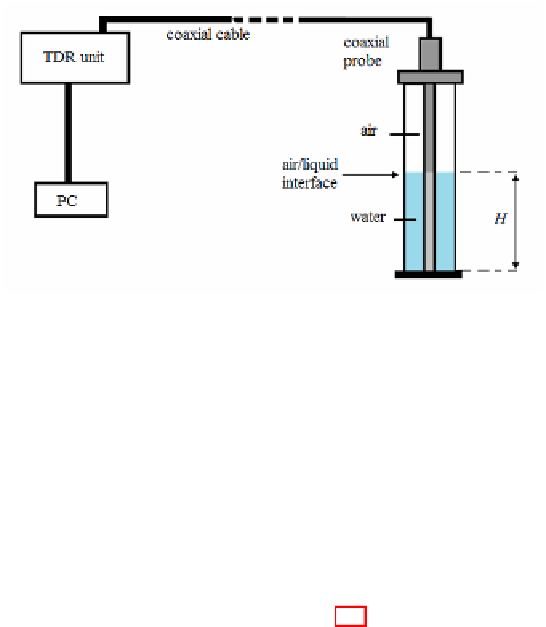Environmental Engineering Reference
In-Depth Information
Fig. 4.1
Setup for TDR-based liquid level measurements: the probe is immersed in the liquid,
and it is connected to the TDR instrument (which, in turn, is controlled through a computer)
4.2.1
Probe Design and Realization
As aforementioned, coaxial probes are the wisest choice for applications on liquids.
This probe configuration can guarantee the insertion into the liquid samples, the me-
chanical stability, the electromagnetic continuity with the connection to the coaxial
cable, as well as an adequate impedance matching. This strongly enhances the over-
all performance of the measurement method. The first aspect to take into account
is the minimization of the impedance mismatches along the line (i.e., TDR unit,
coaxial cable and probe in air), so that (4.1) can be considered reasonably valid.
The schematic configuration of the used probe is shown in Fig. 4.2. The designed
coaxial probe is made up of a central cylindrical conductor and of a coaxial stain-
less steel conductive shield. The values of the outer diameter of the inner conductor
(
a
) is 10 mm, whereas the inner diameter of the hollow outer conductor (
b
)is23
mm: these dimensions allow a good 50
-matching, according to (3.14). The outer
conductor is perforated, so as to allow fluid circulation when the coaxial probe is im-
mersed in the liquid (four series of holes with a diameter of 8 mm and 3 cm-spaced,
are made longitudinally along the external hollow conductor). The 1 cm-thick metal-
lic flange facilitates the positioning of the probe in the tank/sample holder (hence, it
can be customized in order to fit the required operating conditions). The longitudinal
cross-section scheme, reported in Fig. 4.2, clearly shows the other design details.
The probe-head and the outer conductor are 6 cm and 43.5 cm long, respectively.
The inner conductor is centered on the coaxial probe-head, through a 2 cm-teflon
ring, while the lower part of the coaxial probe (probe-end point) is open-ended.
The adopted 50
Ω
-matched coaxial probe shows very good performance in terms
of impedance mismatching minimization. This can be seen from Fig. 4.3, which
shows that the measured reflection coefficient associated to the probe in air is ap-
proximately zero.
Ω




Search WWH ::

Custom Search